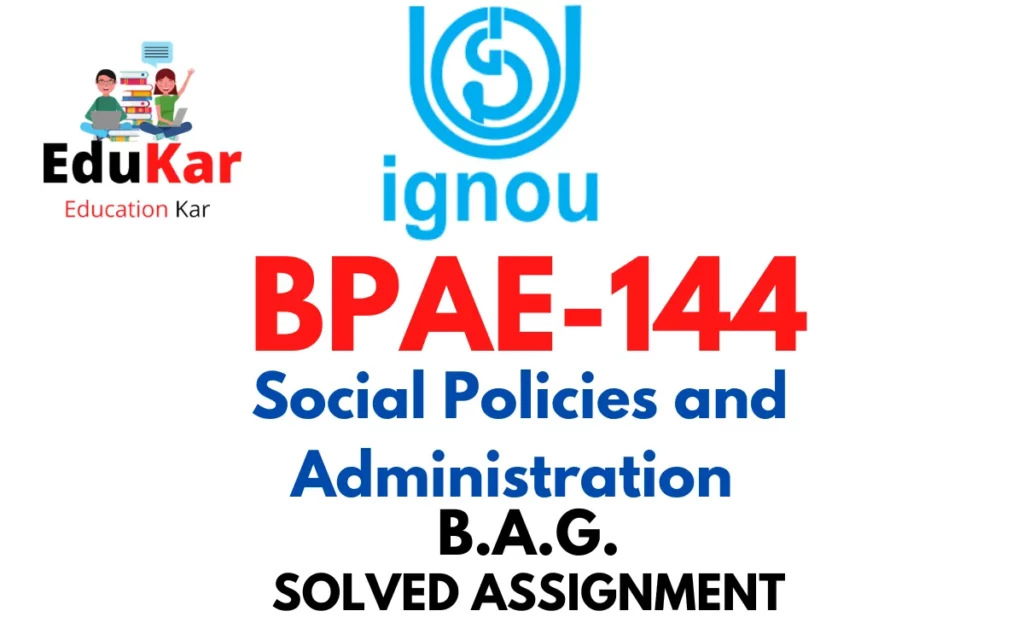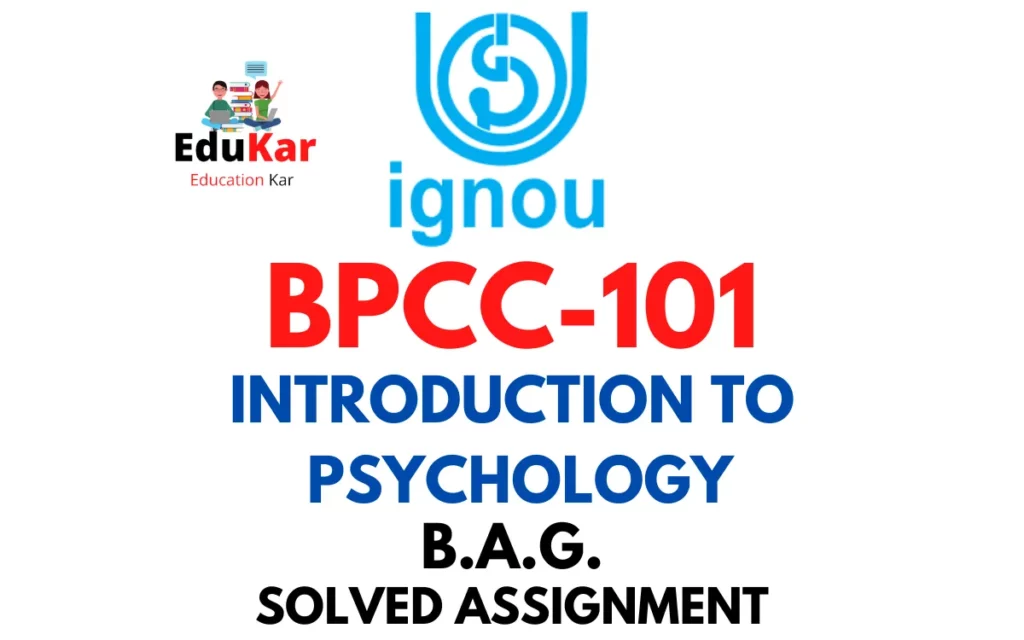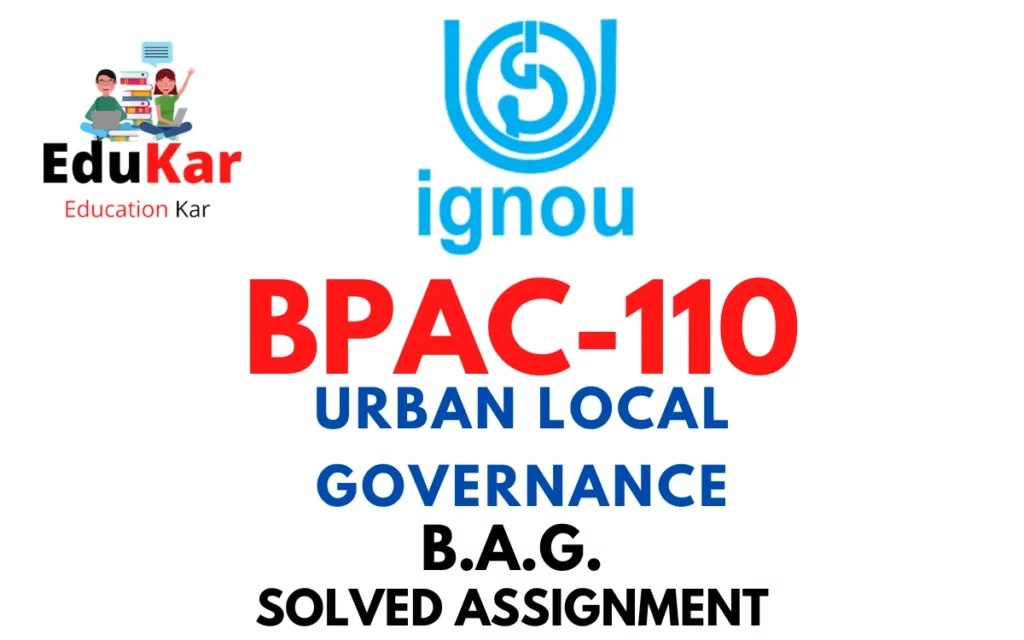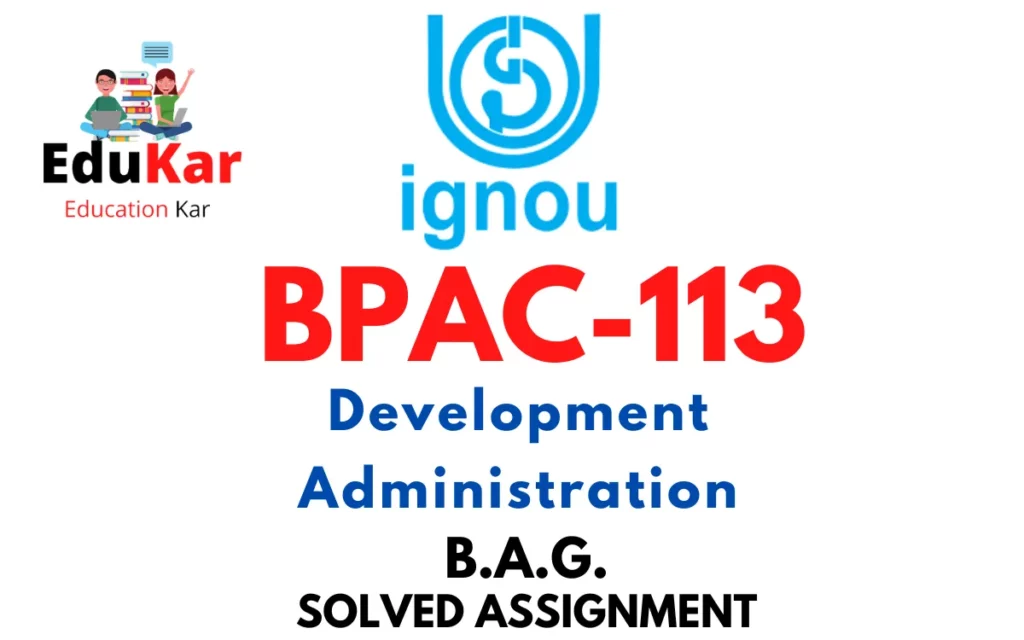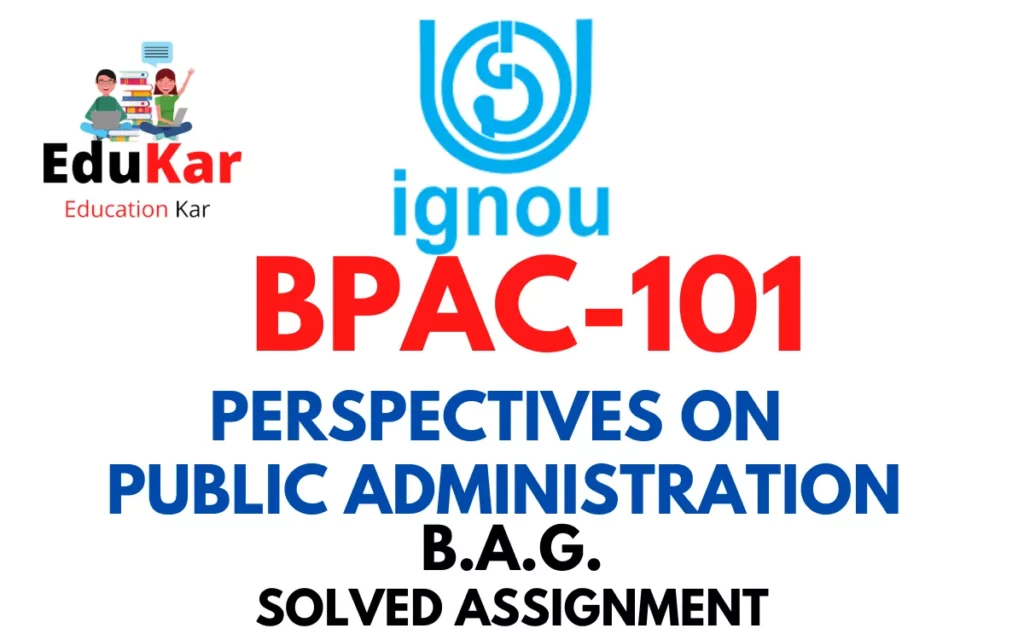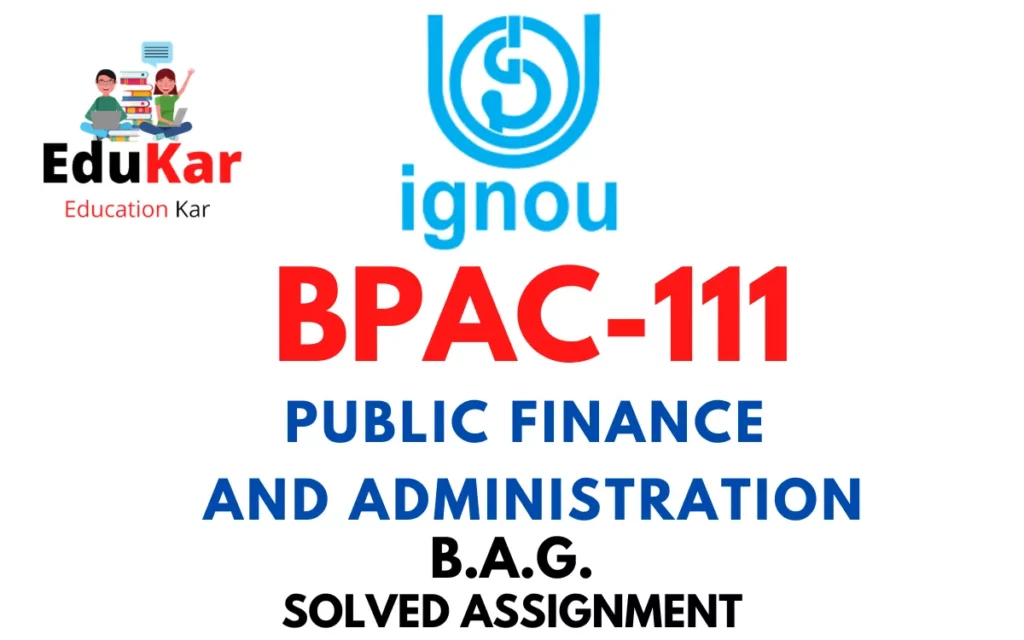Contents
- 1 Assignment A
- 2 Answer the following in about 500 words each.
- 3 1. Discuss the meaning, nature and scope of public policy.
- 4 2. Describe the nature of policy analysis, underlining its process and framework.
- 5 Assignment B
- 6 Answer the following questions in about 250 words each.
- 7 3. Describe the relationship between the nature of State and public policy.
- 8 4. Briefly discuss the Estonian model of policy analysis.
- 9 5. Examine the techniques of policy evaluation.
- 10 Assignment C
- 11 Answer the following questions in about 100 words each.
- 12 6. What are the propositions of the elite-mass theory?
- 13 7. What do you mean by interest groups?
- 14 8. Define civil society.
- 15 9. Write a short note on the concept of social process.
- 16 10. Mention the various constraints in policy monitoring.

| Title | BPAC-106: IGNOU BAG Solved Assignment 2022-2023 |
| University | IGNOU |
| Degree | Bachelor Degree Programme |
| Course Code | BPAC-106 |
| Course Name | UNDERSTANDING PUBLIC POLICY |
| Programme Name | Bachelor of Arts (General) |
| Programme Code | BAG |
| Total Marks | 100 |
| Year | 2022-2023 |
| Language | English |
| Assignment Code | ASST /TMA / July 2022 & January 2023 |
| Assignment PDF | Click Here |
| Last Date for Submission of Assignment: | For June Examination: 31st April For December Examination: 30th September |
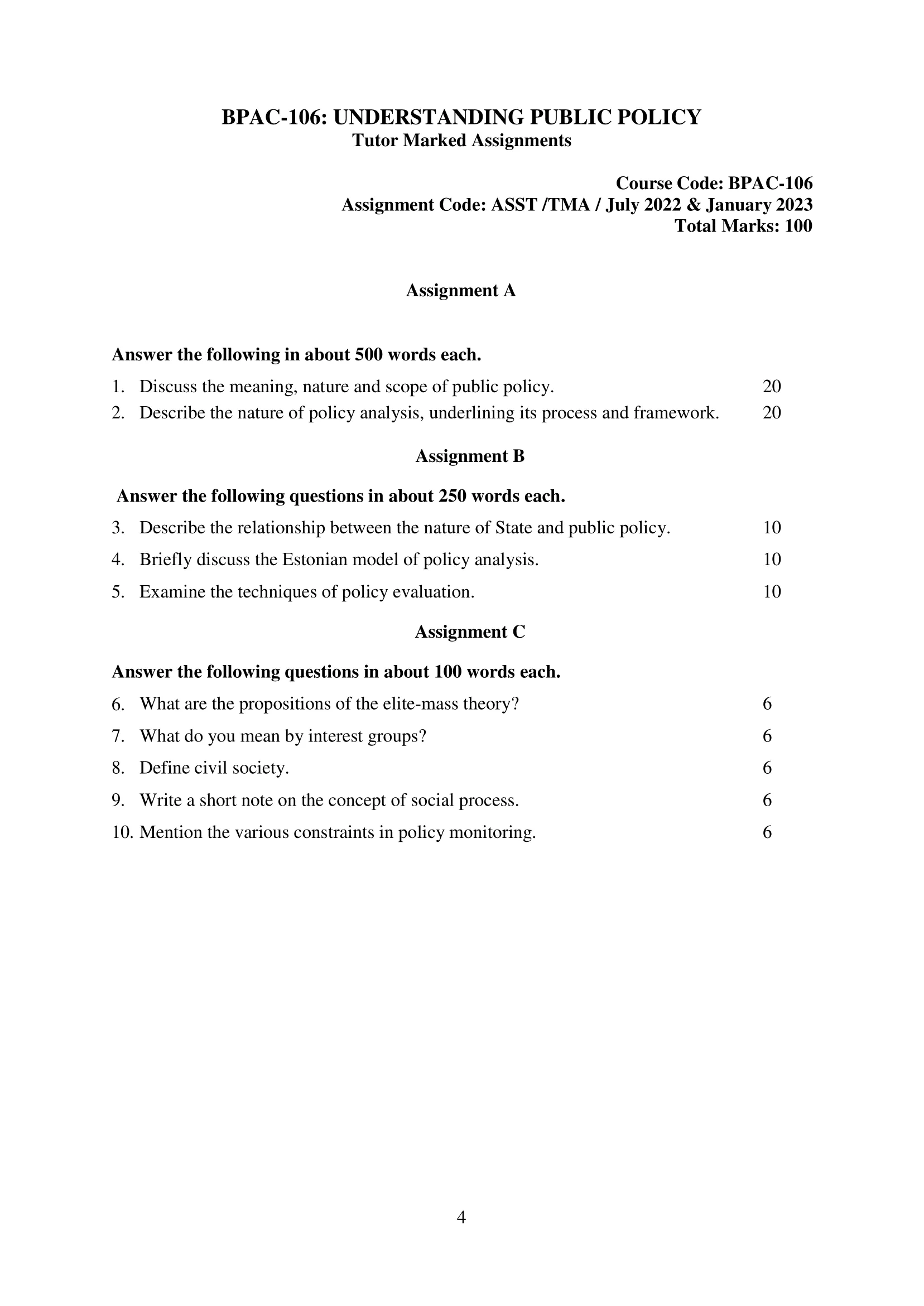
Assignment A
Answer the following in about 500 words each.
1. Discuss the meaning, nature and scope of public policy.
Ans: Public policy is a term that refers to the actions and decisions made by governments to address public issues. It encompasses a wide range of activities, including legislation, regulation, funding, and public administration. Public policy is critical to the functioning of modern societies, as it provides the framework within which governments can address social, economic, and environmental challenges. In this essay, we will discuss the meaning, nature, and scope of public policy.
Meaning: Public policy refers to the actions taken by government to address public problems. It can be described as a set of laws, regulations, and programs designed to meet the needs and interests of citizens. Public policy is often developed in response to issues such as poverty, crime, education, healthcare, and the environment. The primary goal of public policy is to improve the quality of life for citizens and promote the common good.
Nature: Public policy is a complex and dynamic process that involves multiple actors, stakeholders, and institutions. It is shaped by a variety of factors, including political, economic, social, and environmental conditions. Public policy is also influenced by values, beliefs, and ideologies that shape the perspectives of policymakers and the public. The nature of public policy is further complicated by the fact that it operates in a constantly changing environment, with new challenges and opportunities emerging over time.
Scope: The scope of public policy is vast and covers a broad range of issues that affect society. Public policy can be divided into several categories, including economic policy, social policy, environmental policy, foreign policy, and defense policy. Economic policy is concerned with issues such as taxation, trade, and employment. Social policy addresses issues related to healthcare, education, welfare, and social justice. Environmental policy focuses on issues such as climate change, pollution, and conservation. Foreign policy is concerned with international relations, diplomacy, and national security. Defense policy addresses issues related to national defense, military strategy, and preparedness.
2. Describe the nature of policy analysis, underlining its process and framework.
Ans: Policy analysis is the systematic process of evaluating the impact, effectiveness, and feasibility of policies. It involves the use of various techniques and methods to study and understand public policies and their intended or unintended consequences. The goal of policy analysis is to provide decision-makers with objective and reliable information to guide the design and implementation of policies.
The policy analysis process typically involves several stages:
- Problem identification: The first step is to identify the issue or problem that the policy is intended to address. This may involve gathering data and information to understand the nature and extent of the problem.
- Policy formulation: The next step is to develop potential solutions or policy options to address the identified problem. This may involve conducting research, reviewing existing policies, and consulting with stakeholders.
- Policy implementation: Once a policy has been formulated, it must be implemented. This may involve developing regulations, establishing procedures, and allocating resources to support the policy.
- Policy evaluation: Finally, the effectiveness of the policy is evaluated. This may involve analyzing data, measuring outcomes, and assessing the costs and benefits of the policy.
The framework for policy analysis typically involves several key components:
- Context: This includes understanding the political, social, and economic context in which the policy is being developed and implemented.
- Stakeholder analysis: This involves identifying and analyzing the various individuals and groups who will be affected by the policy, and their interests and concerns.
- Policy analysis methods: Various methods can be used to analyze policies, such as cost-benefit analysis, impact assessment, and risk assessment.
- Policy options: Once the problem has been identified, different policy options are developed and evaluated.
- Policy implementation: Strategies for implementing the policy are developed, including procedures, resources, and regulatory measures.
- Policy evaluation: The effectiveness and impact of the policy are evaluated using various methods and indicators.
Assignment B
Answer the following questions in about 250 words each.
3. Describe the relationship between the nature of State and public policy.
Ans: The nature of the State is intimately connected with public policy because the State has the responsibility to make policies that benefit its citizens. The State is responsible for providing public goods and services, such as education, healthcare, and transportation. The State is also responsible for regulating the economy, protecting citizens from harm, and providing justice. In order to fulfill these responsibilities, the State must create and implement policies that meet the needs and desires of its citizens.
The nature of the State can influence public policy in several ways. For example, a democratic State may be more likely to implement policies that reflect the wishes of the majority of its citizens. An authoritarian State, on the other hand, may be more likely to implement policies that reflect the interests of the ruling elite. Additionally, the level of development of a State can affect the type of policies that it can implement. For example, a developing country may lack the resources and infrastructure to implement policies that a developed country could easily put into place.
The nature of the State can also influence the effectiveness of public policy. A State that is corrupt, for example, may implement policies that do not benefit its citizens, but instead serve the interests of the ruling elite. Similarly, a weak State may lack the capacity to implement policies effectively, regardless of how well-intentioned those policies may be.
4. Briefly discuss the Estonian model of policy analysis.
Ans: The Estonian model of policy analysis is a unique approach to policy development that emerged after Estonia regained its independence in 1991. It is characterized by a focus on evidence-based policy, participatory decision-making, and a strong emphasis on the use of technology.
The Estonian model of policy analysis emphasizes the use of data and evidence to inform policy decisions. This means that policy decisions are based on a thorough analysis of the available data, including quantitative and qualitative information. The use of evidence is central to the policy-making process, as policymakers are expected to provide a strong rationale for their decisions.
Participatory decision-making is another important feature of the Estonian model. It involves engaging a wide range of stakeholders in the policy development process, including civil society groups, academics, and citizens. This approach is intended to ensure that policies are developed with the input of those who will be most affected by them.
The Estonian model of policy analysis also places a strong emphasis on the use of technology in the policy development process. This includes the use of electronic consultations and online surveys to gather input from stakeholders, as well as the use of data analysis tools to inform policy decisions.
5. Examine the techniques of policy evaluation.
Ans: Policy evaluation is an essential part of the policy-making process as it allows policymakers to assess the effectiveness of existing policies and determine if they are achieving their intended outcomes. There are several techniques that can be used for policy evaluation, each with its own strengths and limitations. Here are some of the most commonly used techniques:
- Cost-benefit analysis: This involves comparing the costs and benefits of a policy to determine if it is cost-effective. It involves quantifying the costs and benefits of a policy in monetary terms, and determining if the benefits outweigh the costs.
- Impact evaluation: This technique involves assessing the actual impact of a policy on its intended outcomes. This may involve gathering data on changes in specific indicators, such as crime rates or graduation rates, and comparing those changes to what would have happened in the absence of the policy.
- Process evaluation: This technique involves assessing how well a policy is being implemented. It may involve examining the administrative processes, staffing levels, and training of staff responsible for implementing the policy to determine if they are effective.
- Qualitative evaluation: This technique involves collecting and analyzing non-numerical data, such as interviews, focus groups, and observations. This can provide insights into the experiences of stakeholders and help identify areas for improvement.
- Comparative analysis: This involves comparing the performance of a policy in one area to its performance in another area, or to the performance of a similar policy in another jurisdiction. This can help identify best practices and areas for improvement.
- Expert review: This technique involves gathering input from subject matter experts to assess the effectiveness of a policy. This can be particularly useful in complex policy areas where technical expertise is required.
Assignment C
Answer the following questions in about 100 words each.
6. What are the propositions of the elite-mass theory?
Ans: The elite-mass theory, also known as the elite theory, is a political theory that proposes that societies are divided into two groups: a small elite of powerful individuals and a large mass of relatively powerless individuals. This theory suggests that the elite group holds the majority of the power in a society, while the mass group has little to no power.
According to this theory, the elite group maintains its power through various means, such as controlling the media, the economy, and political institutions. The mass group, on the other hand, is often excluded from decision-making processes and may not have access to the resources necessary to challenge the power of the elite.
The elite-mass theory suggests that democracy is a façade, and that elections and other democratic processes are controlled by the elite to maintain their power. The theory also suggests that social and economic inequality is a necessary aspect of society, as it ensures the continuation of the power of the elite.
7. What do you mean by interest groups?
Ans: Interest groups, also known as advocacy groups or pressure groups, are organizations that seek to influence government policies and decision-making. These groups are typically composed of individuals who share common interests or goals, and who work together to advocate for their cause.
Interest groups can take a variety of forms, such as professional associations, labor unions, business groups, environmental organizations, and civil rights groups. They may engage in a range of activities, such as lobbying, grassroots organizing, public demonstrations, and litigation.
Interest groups are an important component of democratic societies, as they provide a means for citizens to participate in the political process and to have their voices heard. By advocating for their interests, interest groups help to shape public policy and hold government officials accountable. However, interest groups can also be criticized for favoring the interests of a particular group over the broader public interest, and for using their resources and influence to gain an unfair advantage in the political process.
8. Define civil society.
Ans: Civil society refers to the sphere of social life that exists between the state, the market, and the family. It includes a wide range of voluntary and non-governmental organizations, such as community groups, non-profit organizations, charities, religious institutions, trade unions, and advocacy groups.
Civil society organizations are distinct from the state and the market, in that they are not driven by profit or by the exercise of political power. Instead, they are formed around shared values and interests, and seek to promote the common good. Civil society organizations are often involved in advocacy and public policy work, and may engage in a range of activities, such as community organizing, public education, and the provision of social services.
Civil society is an important component of democratic societies, as it provides a space for citizens to engage in public life and to work together to address common challenges. It can help to promote social cohesion, democratic participation, and accountability, and can serve as a counterbalance to the power of the state and the market.
Ans: Social process refers to the various ways in which people interact with each other, form relationships, and engage in collective actions that shape society. It is the study of how individuals, groups, and communities interact, form social structures, and create cultural norms and values.
Social process is a broad concept that encompasses a range of social phenomena, including communication, socialization, cultural development, and social change. These processes are shaped by a variety of factors, including historical, cultural, and economic contexts, and can vary across different societies and communities.
One key aspect of social process is the concept of socialization, which refers to the process by which individuals learn and internalize the norms, values, and beliefs of their society. This process begins in childhood and continues throughout the lifespan, as individuals learn from their family, peers, and institutions such as schools and religious organizations.
Social process is also closely linked to the concept of social change, which refers to the ways in which societies and communities evolve and transform over time. Social change can occur through a variety of processes, including social movements, technological advances, and shifts in cultural norms and values.
10. Mention the various constraints in policy monitoring.
Ans: Policy monitoring is a crucial component of the policy-making process as it helps policymakers assess the effectiveness of their policies and identify areas for improvement. However, there are several constraints that can limit the effectiveness of policy monitoring. Some of these constraints include:
- Lack of resources: Monitoring policies can be resource-intensive, requiring a significant amount of time, money, and staff. Policymakers may not have sufficient resources to devote to monitoring their policies, leading to incomplete or inadequate monitoring efforts.
- Lack of data: Monitoring requires access to relevant and reliable data. However, data may not be available or may be incomplete, making it difficult to assess the effectiveness of policies.
- Lack of political will: Monitoring may reveal areas of policy failure or inadequacy, which can be politically difficult to address. Policymakers may be reluctant to engage in monitoring efforts if they fear negative feedback or political backlash.
- Difficulties in attribution: It can be difficult to attribute changes in outcomes to specific policies, as there may be multiple factors influencing the outcome. This can make it difficult to determine the effectiveness of policies.
- Lack of stakeholder engagement: Monitoring efforts may be undermined if stakeholders are not engaged in the process. This can lead to policies that do not reflect the needs or experiences of those they are intended to serve.
How to Download BPAC-106 Solved Assignment?
You can download it from the www.edukar.in, they have a big database for all the IGNOU solved assignments.
Is the BPAC-106 Solved Assignment Free?
Yes this is absolutely free to download the solved assignment from www.edukar.in
What is the last submission date for BPAC-106 Solved Assignment?
For June Examination: 31st April, For December Examination: 30th October




